The Resin Pigments Market is estimated to be valued at USD 2978.9 million in 2025 and is projected to reach USD 5805.4 million by 2035, registering a compound annual growth rate (CAGR) of 6.9% over the forecast period.
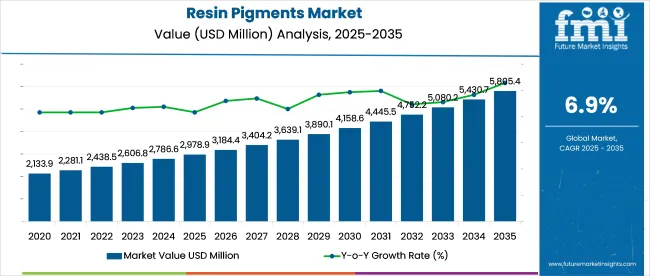
The resin pigments market is witnessing consistent expansion, driven by growing industrial demand for durable and vibrant colorants across multiple end use sectors. Industry journals and product development updates have highlighted advancements in pigment formulations, enhancing color consistency, weather resistance, and chemical stability.
Manufacturers have responded to stringent environmental regulations by optimizing pigment compositions for lower volatile organic compounds and enhanced dispersion characteristics. Increased production in the paints & coatings sector, combined with growth in plastics, adhesives, and printing inks, has further propelled pigment consumption.
Strategic expansions by pigment manufacturers and material suppliers have strengthened supply chains, ensuring a steady supply of high performance pigments for industrial applications. Looking forward, the market is expected to benefit from the adoption of high performance synthetic pigments and sustained demand for powder based solutions. Segmental growth is expected to be driven by Powder Pigments as the preferred type, Synthetic pigments as the dominant source, and Paints & Coatings as the key end use industry, reflecting industrial performance requirements and market consumption patterns.
The market is segmented by Type, Source, and End Use Industry and region. By Type, the market is divided into Powder Pigments and Liquid Pigments. In terms of Source, the market is classified into Synthetic and Natural/Organic. Based on End Use Industry, the market is segmented into Paints & Coatings, Printing Inks, Plastics, Textiles, Cosmetics, Food, and Others Applications.
Regionally, the market is classified into North America, Latin America, Western Europe, Eastern Europe, Balkan & Baltic Countries, Russia & Belarus, Central Asia, East Asia, South Asia & Pacific, and the Middle East & Africa.

The Powder Pigments segment is projected to contribute 54.6% of the resin pigments market revenue in 2025, retaining its dominant market position among pigment forms. Growth of this segment has been influenced by the ease of handling, longer shelf life, and excellent dispersibility of powder pigments in various resin matrices.
Industrial users have favored powder pigments for their ability to deliver high pigment concentration and stable performance during production and application processes. Manufacturers have optimized powder pigment formulations for enhanced compatibility with solvent based and water based resins, improving color uniformity and surface finish.
Additionally, powder pigments have demonstrated superior resistance to heat and UV exposure, making them suitable for outdoor and industrial grade applications. The cost effectiveness of powder pigments, combined with their ease of storage and transportation, has further contributed to their widespread adoption. As industries continue to prioritize material efficiency and product performance, the Powder Pigments segment is expected to maintain its leadership in the market.
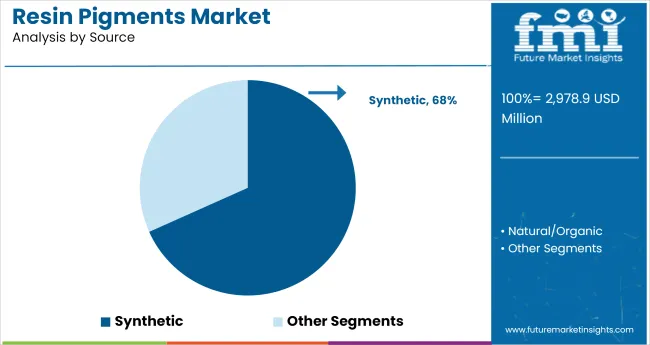
The Synthetic segment is projected to hold 68.3% of the resin pigments market revenue in 2025, establishing itself as the leading pigment source. Growth of this segment has been driven by the superior chemical stability, consistent quality, and wide color range offered by synthetic pigments compared to natural alternatives.
Synthetic pigments have been engineered to meet the performance demands of industrial applications, providing excellent dispersion, lightfastness, and resistance to chemical degradation. Industrial manufacturers have preferred synthetic pigments for large scale production due to their predictable supply chain and customizable properties.
Additionally, synthetic pigment production has allowed manufacturers to achieve vibrant and specialty color shades that meet evolving aesthetic trends in coatings, plastics, and construction materials. Regulatory compliance and product safety testing have reinforced the adoption of synthetic pigments in sensitive applications such as food packaging and consumer goods. As industries continue to demand high performance, application specific pigments, the Synthetic segment is expected to remain the dominant source in the market.
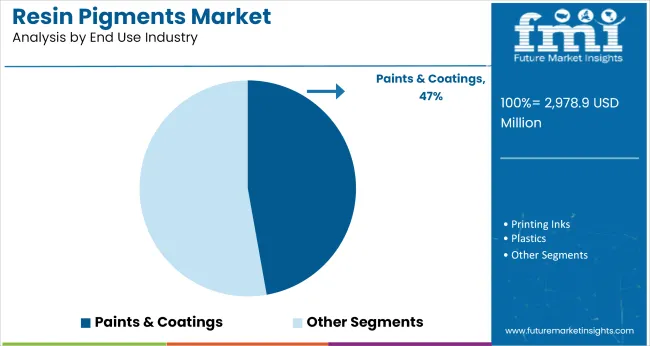
The Paints & Coatings segment is projected to account for 47.2% of the resin pigments market revenue in 2025 sustaining its position as the primary end use industry. Growth of this segment has been fueled by the extensive use of resin pigments in architectural, automotive, industrial, and marine coatings to provide vibrant, durable, and protective finishes.
Paint manufacturers have relied on resin pigments to enhance surface aesthetics, corrosion resistance, and the weatherability of coatings applied in harsh environmental conditions. Continuous product innovations in low VOC and high solid coatings have maintained strong pigment demand from the paints & coatings sector.
Additionally, the rise in global construction activity and infrastructure development has driven consumption of decorative and protective coatings containing resin pigments. Expanding automotive production and the trend toward customization and metallic finishes have further increased pigment usage in vehicle coatings. With industrial sectors prioritizing both performance and appearance, the Paints & Coatings segment is expected to remain the largest consumer of resin pigments.
Increased use of the product in the paints & coatings, plastics, and textile industries is expected to drive global market growth. Colorants made from resin pigments are widely used in the plastics and textile industries.
Because of the widespread use of plastics in packaging applications, the plastics industry is rapidly expanding. In the future years, this is likely to boost demand for resin pigments and propel global market expansion.
Furthermore, rising demand for resin pigments in the creation of printing inks is expected to be a major driver of global market expansion. Nonetheless, the expanding spectrum of resin pigment applications in the electronics industry is expected to provide profitable prospects for market players in the coming years.
The market players are concentrating their efforts on research and advanced technology, which is expected to boost sales during the forecast period.
Harima's resins and tall oil products division, for example, draws on a wealth of advanced technologies and know-how to meet the diverse functional and performance requirements of printing inks, paints, adhesives, synthetic rubbers, and a variety of other consumer goods. In the sectors of printing ink resin, adhesive resin, and synthetic rubber emulsifier, the company offers a wide range of key goods.
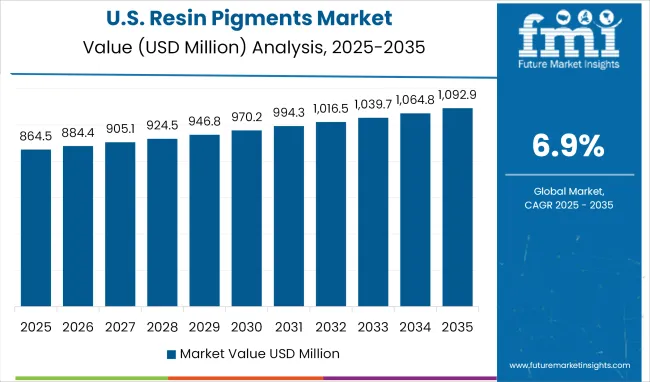
Increasing construction activity in North America is expected to drive up pigment demand over the forecast period. Plastics and printing inks are two other important application industries that contribute to market demand.
Construction spending was anticipated at a seasonally adjusted annual rate of USD 1,568.8 billion in July 2024, up 0.3 percent (1.2 percent)* from the revised June estimate of USD 1,563.4 billion, according to the US Census Bureau.
Publication print inks, offset inks, solvent packaging inks, decorative laminate inks, and water-based packaging inks all use the product. These are also frequently utilized in plastic applications, namely for cosmetics, healthcare, food and beverage packaging, and other consumer products packaging.
During the review period, the plastic application segment is expected to earn significant revenue due to rising food and beverage demand as well as rising cosmetics demand.
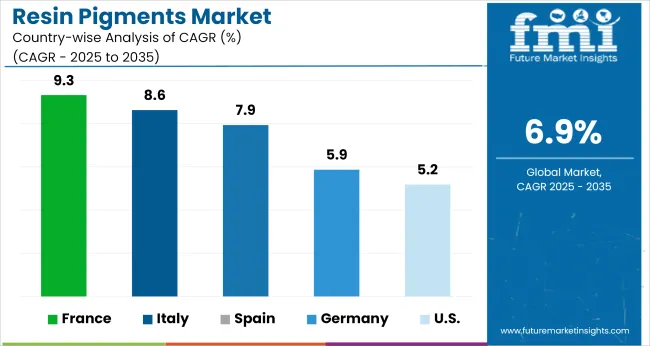
The rise of the resin pigments market could be due to the rising demand for packaged food. Furthermore, resin manufacturers' R&D and innovation are moving the sector forward. The market is benefiting from the increased usage of polyurethane resin in flexible packaging, which is pushing up demand for resin pigments in Europe.
Furthermore, demand for environmentally friendly resin pigments is predicted to increase in the region. Colorberry pigment pastes, for example, were produced and chosen by MRS.COLORBERRY exclusively for colouring resin.
They're made and bottled in Germany, with their own quality control to ensure complete client pleasure. All colors in the COLORBERRY RESIN PIGMENT PASTE range have been laboratory tested and conform to ASTM-D4236. Because the pigments are mixed differently, each color has a different consistency.
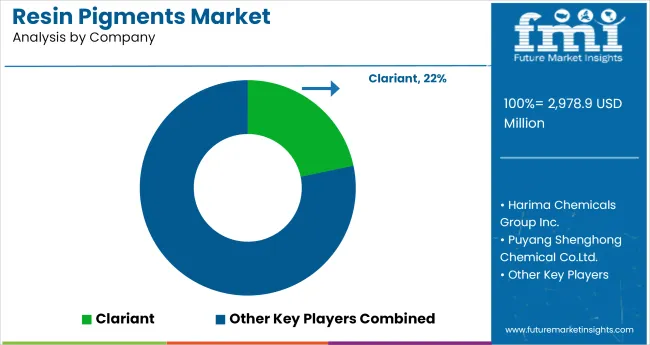
Some of the leading manufacturers/suppliers include
The report is a compilation of first-hand information, qualitative and quantitative assessment by industry analysts, inputs from industry experts and industry participants across the value chain. The report provides in-depth analysis of parent market trends, macro-economic indicators and governing factors along with market attractiveness as per segments. The report also maps the qualitative impact of various market factors on market segments and geographies.
The global resin pigments market is estimated to be valued at USD 2,978.9 million in 2025.
The market size for the resin pigments market is projected to reach USD 5,805.4 million by 2035.
The resin pigments market is expected to grow at a 6.9% CAGR between 2025 and 2035.
The key product types in resin pigments market are powder pigments and liquid pigments.
In terms of source, synthetic segment to command 68.3% share in the resin pigments market in 2025.






Our Research Products

The "Full Research Suite" delivers actionable market intel, deep dives on markets or technologies, so clients act faster, cut risk, and unlock growth.

The Leaderboard benchmarks and ranks top vendors, classifying them as Established Leaders, Leading Challengers, or Disruptors & Challengers.

Locates where complements amplify value and substitutes erode it, forecasting net impact by horizon

We deliver granular, decision-grade intel: market sizing, 5-year forecasts, pricing, adoption, usage, revenue, and operational KPIs—plus competitor tracking, regulation, and value chains—across 60 countries broadly.

Spot the shifts before they hit your P&L. We track inflection points, adoption curves, pricing moves, and ecosystem plays to show where demand is heading, why it is changing, and what to do next across high-growth markets and disruptive tech

Real-time reads of user behavior. We track shifting priorities, perceptions of today’s and next-gen services, and provider experience, then pace how fast tech moves from trial to adoption, blending buyer, consumer, and channel inputs with social signals (#WhySwitch, #UX).

Partner with our analyst team to build a custom report designed around your business priorities. From analysing market trends to assessing competitors or crafting bespoke datasets, we tailor insights to your needs.
Supplier Intelligence
Discovery & Profiling
Capacity & Footprint
Performance & Risk
Compliance & Governance
Commercial Readiness
Who Supplies Whom
Scorecards & Shortlists
Playbooks & Docs
Category Intelligence
Definition & Scope
Demand & Use Cases
Cost Drivers
Market Structure
Supply Chain Map
Trade & Policy
Operating Norms
Deliverables
Buyer Intelligence
Account Basics
Spend & Scope
Procurement Model
Vendor Requirements
Terms & Policies
Entry Strategy
Pain Points & Triggers
Outputs
Pricing Analysis
Benchmarks
Trends
Should-Cost
Indexation
Landed Cost
Commercial Terms
Deliverables
Brand Analysis
Positioning & Value Prop
Share & Presence
Customer Evidence
Go-to-Market
Digital & Reputation
Compliance & Trust
KPIs & Gaps
Outputs
Full Research Suite comprises of:
Market outlook & trends analysis
Interviews & case studies
Strategic recommendations
Vendor profiles & capabilities analysis
5-year forecasts
8 regions and 60+ country-level data splits
Market segment data splits
12 months of continuous data updates
DELIVERED AS:
PDF EXCEL ONLINE
Resin Silencer Market Size and Share Forecast Outlook 2025 to 2035
Resin Capsule Market Forecast and Outlook 2025 to 2035
Resin Cement for Luting Market Size and Share Forecast Outlook 2025 to 2035
PE Resins Market Size and Share Forecast Outlook 2025 to 2035
Ink Resin Market Size and Share Forecast Outlook 2025 to 2035
Cast Resin Transformer Market Size and Share Forecast Outlook 2025 to 2035
Agar Resin Market
Epoxy Resin Industry Analysis in Asia Pacific Size and Share Forecast Outlook 2025 to 2035
Furan Resin Market Size and Share Forecast Outlook 2025 to 2035
Amino Resin Market Growth - Trends & Forecast 2025 to 2035
Epoxy Resin Market Growth – Trends & Forecast 2024-2034
Cobalt Resinate Market Size and Share Forecast Outlook 2025 to 2035
Compact Resin Type Silencer Market Size and Share Forecast Outlook 2025 to 2035
Acrylic Resin Market Size and Share Forecast Outlook 2025 to 2035
Barrier Resins Market Size and Share Forecast Outlook 2025 to 2035
Coating Resins Market Size and Share Forecast Outlook 2025 to 2035
Plastic Resins Market Size, Share & Forecast 2025 to 2035
Phenolic Resins Market Size and Share Forecast Outlook 2025 to 2035
Composite Resin Market Size and Share Forecast Outlook 2025 to 2035
Iodinated Resins Market Analysis - Size, Share, and Forecast Outlook 2025 to 2035

Thank you!
You will receive an email from our Business Development Manager. Please be sure to check your SPAM/JUNK folder too.
Chat With
MaRIA